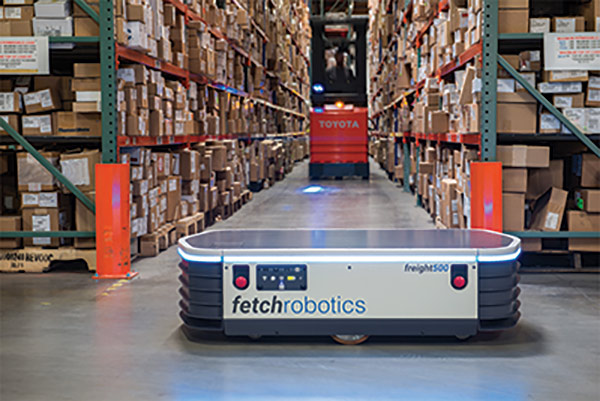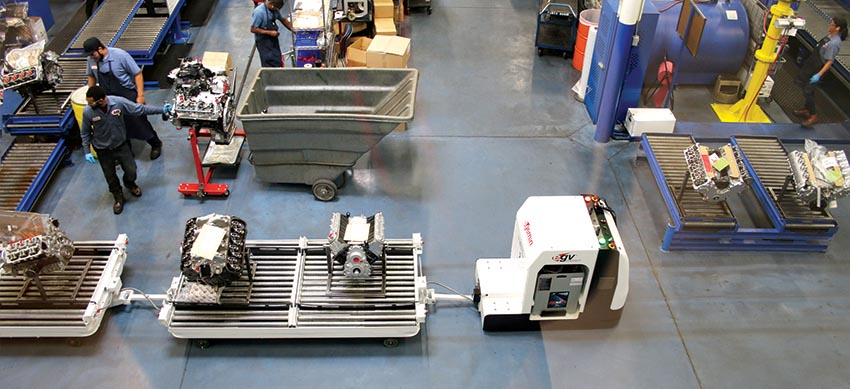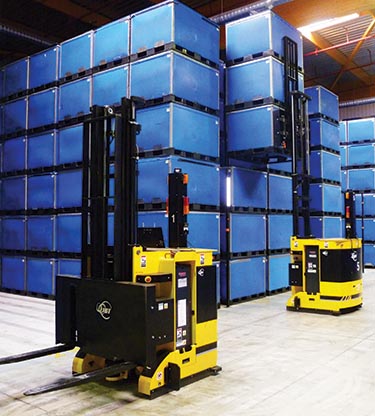AGVs: Predictably Flexible
Forget what you thought you knew about AGVs. Mobile robot start-ups and half-century industry veterans alike are delivering a new generation of autonomous coworkers.

Automatic guided vehicle (AGV) or cart (AGC). Autonomous mobile robot (AMR). Vision-guided vehicle (VGV). Self-driving vehicle (SDV). And there will likely be more additions to this list of acronyms in the coming year, as mobile automation is here to stay in warehousing, distribution and manufacturing. It’s no surprise that AGV innovation is so far outpacing adoption, but between e-commerce, labor shortages and lower costs for the technology, these solutions are primed to spread quickly.
Of course, the speed with which automation is advancing often causes anxiety for risk-averse materials handling professionals. Then again, everyone remembers at least one of the technological revolutions of recent decades, and we’ll need to apply all the lessons learned to successfully navigate the next one.
When computers reached mass adoption, accountants feared for their jobs. It was a piece of technology that performed part of the accountant’s job better. What nobody saw coming, according to Simon Drexler, director of products for OTTO Motors, a division of Clearpath, was the emergence of entirely new industries like video games and the Internet.
“The fourth industrial revolution has the same potential,” Drexler says, “but a lot of companies have a hard time taking the first step. You say ‘Industry 4.0’ or ‘smart factory,’ and you get a deer-in-the-headlights look. It sounds a lot more daunting than it really is. A lot of the technologies coming to market are quite easy to use, and you don’t need to be a robotics expert. Mobile robots and automatic industrial vehicles are crossing the chasm. We will see rapid adoption in the coming years, and it will change the way we work and the data that’s available to us about our processes, which will lead to yet another transformation.”’
The solutions are already widely used in materials handling applications in other parts of the world, Drexler warns, so if North America doesn’t keep pace, it could lose a competitive advantage. To help Modern’s readers navigate the automation path, a group of industry experts helped us outline some of the key considerations when evaluating, deploying and leveraging AGV technologies.

Indicator lights, workstation-mounted command buttons and other means of communication can help develop engagement between AGVs and human coworkers while gathering important process information.
An AGV by any other name
First, AGV is an all-encompassing umbrella term for the wide scope of wheeled, mobile, industrial materials handling solutions. With half a century in the industry’s acronym soup, “AGV” brings a lot of baggage. Those who’ve used them might describe them as reliable, safe and efficient, and those who have avoided or dismissed them until now might lean toward “old school,” inflexible and slow.
“There is a misconception that an AGV has to have a permanent path, be it tape, paint, wire or magnets,” says John Clark, mobile automation marketing manager for Dematic. “There are not a lot of current AGV scenarios utilizing that kind of fixed infrastructure. Most of today’s AGVs use laser- or camera-guided navigation, although we do see combinations that use multiple navigation modes depending on where it is in a facility.”
An AMR can be an AGV, or vice versa, Clark says, and whatever the acronym, customers often get stuck on the word “autonomous” or “robot.” There’s a tremendous amount of overlap, he says, and the lines will only continue to blur. Not only are AGVs incorporating some of the functionality of AMRs, there is also plenty of blending between an AGV and a traditional human-operated lift truck, which have spawned their own assortment of terms like hybrid and dual-use.
How might any of these variations fit into existing standards for AGVs, lift trucks, carts or other industrial vehicles? The short answer is that they don’t.
“AMRs are not well-regulated under ANSI/ITSDF B56.5-2012,” says Melonee Wise, chief executive officer of Fetch Robotics. “It does not apply well and should not be used as the standard. For one thing, the standard requires a guide path, and AMRs navigate without them. There’s an industry joke that a good workaround would be a sign outside the facility designating the entire building as a guide path.”
Wise says AGVs and AMRs are distinctive not just because of the description of a vehicle’s size or navigation system, but the definition of the overall system design and behavior. AMRs are intended to grant full ownership to the user, with intuitive interfaces and the ability to reprogram in as little as 5 minutes. As Drexler mentioned, this is a trend across the autonomous industrial vehicle spectrum. Wise adds that the Cloud-based systems controlling AMRs lower on-site IT costs and enable remote monitoring, diagnostics and analysis.
“Maybe the user wants to experiment and test, and we can remotely verify if a configuration is sound,” Wise says. “We use that data to create recommendations to improve workflows, not just at the time of installation, but as you evolve with the system. If analysis shows one lane is routinely blocked, we can make traffic recommendations.”
Wise adds that because a vehicle’s safety sensors override any software commands, Cloud-based systems also boost cybersecurity. That said, existing safety standards tend to focus on the safety of humans, not other equipment and assets. For example, some AGVs use planar two-dimensional sensors that can identify things like a person’s legs, but not cantilevered lift truck forks.
“I recommend anyone investigating any AGV or AMR should ask what kinds of other equipment it can work around,” Wise says. “Some AMRs have 3D collision avoidance, but not all AMRs are made to work near lift trucks. Make sure you understand the requirements in the environment and all interactions with people and materials handling equipment.”
Because prevailing standards are never the be-all and end-all for establishing safety, Wise says task-based risk assessments remain a critical tool that enables otherwise unregulated AGV technologies to be safely deployed.
Reviewing the AGV résumé
In addition to a risk assessment, a thorough understanding of the application is also important before evaluating solutions. Laura McConney, marketing specialist for JBT Corp., says customer excitement can often become a barrier when they have no sense of where or how an AGV might be installed.
 “Sure, we could come and just sell you some expensive and automated system, but we don’t have the same insight into your system,” McConney says. “Have some sort of plan. What is the application? Throughput? Types of loads? The more data they can provide from the get-go, the better off they are.”
“Sure, we could come and just sell you some expensive and automated system, but we don’t have the same insight into your system,” McConney says. “Have some sort of plan. What is the application? Throughput? Types of loads? The more data they can provide from the get-go, the better off they are.”
She also echoes the sentiments of other experts in suggesting that customers leave their assumptions at the door.
“AGVs get a bad rap because people don’t understand their capabilities,” McConney says. “We’re now seeing vehicles able to access higher and lower locations, and doing it all faster than before. They used to be limited to 20 to 25 feet, but they can now reach 30 feet, which is huge when it opens up another rung of racking. And horizontal speed is getting up to 3 meters per second, where they previously topped out at 2 meters per second.”
New sensors and camera technology mounted on the forks can help precisely orient them, McConney adds, and other sensors monitor the forks’ position relative to the floor, which adds precision and stability. From small carts with 75-pound payloads to massive fork-style AGVs, the variation of solutions is mirrored in the customer demand.
“Some want one or two units, others want to immediately install automation throughout a building – or multiple buildings,” she says. “It’s kind of the Wild West right now.”
Part of the new frontier centers on the reactions of humans to their new autonomous coworkers. To combat some of the lawlessness, solution providers have been exploring ways to add familiar modes of communication to unfamiliar equipment. Something as simple as an indicator light can convey important information, in the same way a human might simply wave to a passing coworker or maintenance technician.
“It’s all part of the growing envelope of machines and humans working together,” says Jeff Leuwerke, senior applications engineer for Banner Engineering. “Automated equipment usually has a lot of smarts built in, but those smarts aren’t always visible. A natural outcome of AGVs becoming a bigger part of our workforce is building awareness for the people working around it.”
Fittingly, wireless components can help tether the AGV to the conventions of its fellow employees. An AGV could wirelessly communicate with a “traffic light” at an intersection, or lower a crossbar that alerts nearby workers while enabling the AGV to proceed at optimal speed. A human’s workstation might be outfitted with a simple “request for pickup” button, or other basic commands that give employees a sense of engagement with their autonomous counterparts, and which also collect important process information.
“Wireless products enable the customer to look at overall process design, report equipment status for predictive maintenance, and bring production numbers into a central, Web-based system, but that’s the end point,” Leuwerke says. “The start point is to add simple signals that help add functionality to the automation that’s there.”
Leuwerke says the main goal of any AGV deployment is to perform incremental automation without disrupting operations. Thankfully, nearly all autonomous industrial vehicles can be quickly and easily introduced to existing warehouse environments. They are ideal for a spectrum of operations caught between manual processes or fully automated storage and retrieval systems (AS/RS), and can handle the ebb and flow of peak seasons better than either of the extremes.
Bill Grey, executive sales manager for SSI Schaefer Systems International, says AGVs are many customers’ first foray into automation. Gradual adoption is one of the big advantages, he says. For any AGV project, there’s the vehicle side and the system side. Once the vehicle is specified and the system configured, expanding and adding another AGV requires minimal work and cost.
“However, AGVs do force you to plan and have your processes figured out,” Grey says. “You need to understand and define material flows in a facility, where they come from and where they go. The user will learn a lot about their operation when they have to think about processes, but if you don’t know what your costs are it’s hard to determine if you’re getting a good ROI.”
This could be looked at as a disadvantage for an organization that’s not very organized, he says, or one accustomed to scrambling at the last minute with lift trucks buzzing around at 15 mph. They might have a hard time adjusting to AGVs, which move at a more controlled 3 mph.
“But it’s like the tortoise and the hare,” Grey says, “and AGVs win the race in the end.”
Companies mentioned in this article
- Banner Engineering
- Dematic
- Fetch Robotics
- JBT Corporation
- OTTO Motors, a division of Clearpath
- SSI Schaefer Systems International

Article Topics
Equipment Report News & Resources
Radial stays ahead of the automation curve Wireless Mobility: Ready for the next leg up AGVs set new standards for inventory transportation Inside North Shore Care Supply: Bringing robots to receiving Bergen Logistics: Putting robots to work in a multi-tenant facility High-tech meets low-tech: Automate storage for pallet loads Tuggers, carts work together to increase productivity and ergonomics More Equipment ReportLatest in Materials Handling
Registration open for Pack Expo International 2024 Walmart chooses Swisslog AS/RS and software for third milk processing facility NetLogistik partners with Vuzix subsidiary Moviynt to offer mobility solutions for warehouses Materials Handling Robotics: The new world of heterogeneous robotic integration BSLBATT is looking for new distributors and resellers worldwide Lucas Watson appointed CSO for Körber’s Parcel Logistics business in North America Hyster recognizes Dealers of Distinction for 2023 More Materials HandlingAbout the Author
Subscribe to Materials Handling Magazine

Find out what the world's most innovative companies are doing to improve productivity in their plants and distribution centers.
Start your FREE subscription today.
April 2024 Modern Materials Handling

Latest Resources










